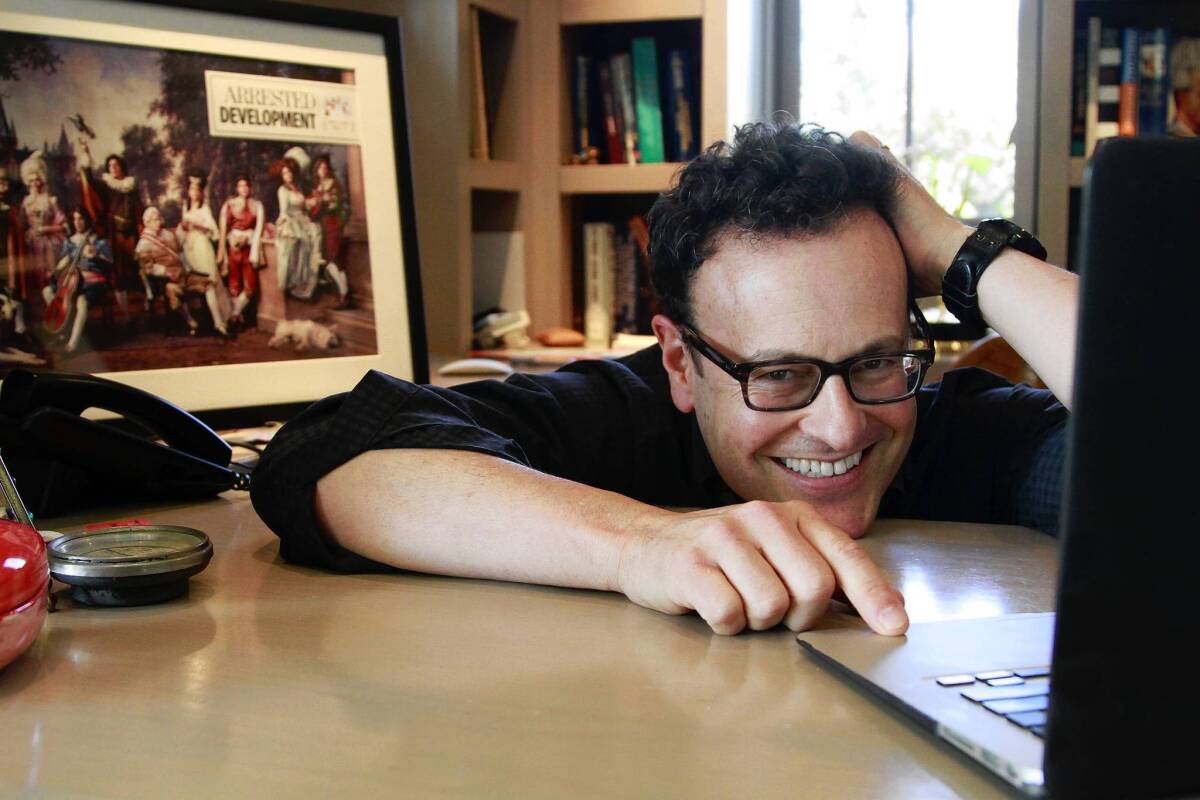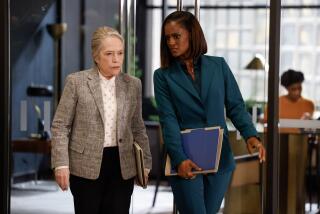‘Arrested Development’ reopens on Netflix, could build from there

- Share via
You might think that Mitchell Hurwitz, the creative mastermind behind the oddball cult comedy “Arrested Development,” would be overjoyed to hear about the crowds thronging the Bluth’s Original Frozen Banana Stands popping up across the country.
But late last week, just days after completing the 15 new “Arrested Development” episodes that will debut on Netflix Sunday, Hurwitz was feeling a little overwhelmed. The long lines outside the sweet dispensaries offered a clever bit of inside-joke promotion — “There’s always money in the banana stand” — and a visual representation of the sky-high expectations for the show’s return.
“Somebody sent me a picture of the lines at the banana stand in New York, and I was like, ‘Oh no, they’re going to be horribly disappointed,’” Hurwitz said. “What could live up to that?”
It is true that this incarnation of “Arrested Development” has a lot to live up to. Loyalists venerate the series about the dysfunctional Orange County Bluth family with the sort of reverence typically reserved for such sci-fi-inflected series as “Lost” or “The X-Files.” Among comedies, perhaps only the original BBC edition of “The Office” starring Ricky Gervais might inspire the same kind of devotion.
PHOTOS: Dysfunctional TV families
Employing cinéma vérité style and deadpan voice-over narration from executive producer Ron Howard, “Arrested Development” premiered in 2003 on Fox, introducing the world to the back-stabbing, chicken-dancing Bluths, anchored by the (comparatively) responsible Michael (Jason Bateman) and his son George-Michael (Michael Cera), and father George Sr. (Jeffrey Tambor), who spent much of the story in jail for SEC violations and a little “light treason.”
His wife, Jessica Walter’s boozy, abusive Lucille, presided over, and fostered, petty squabbles among Michael and her other children, Portia de Rossi’s superficial Lindsay, Will Arnett’s loser magician Gob (pronounced Job, as in the Old Testament) and Tony Hale’s man-child Buster. Lindsay had her own struggles with her “never nude” husband Tobias Fünke (David Cross) and their daughter Maeby (Alia Shawkat) — the cousin on whom George-Michael had a massive crush.
Although it captured more Emmys in 2004 than HBO’s “The Sopranos” — “Arrested Development” won five for its first season, including comedy series — it never managed to catch on with a sizable mainstream audience. In its first year, it ranked 116th in ratings.
“At the time, it was felt, possibly correctly, that the density of the show was what kept an audience from finding it,” Hurwitz said in an interview at his Pacific Palisades home. “There was a constant debate about whether we should really simplify this. My feeling was, I’m just going to lose the people I have now if we simplify the show.”
PHOTOS: Meet the ‘Arrested Development’ cast
By the time the series concluded in 2006, Fox aired the final four episodes opposite the opening ceremonies of the Winter Olympics.
Over the years, though, the show inspired a quirky following, with fans rediscovering it on DVD. The creative forces behind the series moved on to other projects in film and television. Hurwitz and Arnett teamed up for a short-lived comedy “Running Wilde,” and Bateman carved out a successful film career that included “Horrible Bosses” and “Identity Thief.” But questions about an “Arrested Development” reunion never died.
“For many, many years I’ve been asked what was happening with the show, but that’s just so great,” De Rossi said. “I mean, how many TV shows have this kind of second chance or this life to them that people actually want to see more, want to check in with the Bluths to see what they’re doing?”
Hurwitz always believed the Bluths would return — but on film, not television. When he began to work on the feature script in 2011, he quickly realized that a screenplay would involve crafting fresh introductions to the characters to bring moviegoers up to speed.
ESSAY: ‘Arrested Development’ kicks critics in the teeth
“I thought, the movie will have to start with five minutes of each character and what they’ve been doing, but then I’m halfway through the movie and nobody’s had a conversation,” he said.
He then became fascinated with the idea of bringing back “Arrested Development” to TV, and adopting an anthology-inspired format with one episode centering on each of the nine main characters. The scope quickly grew to 15 episodes, with some characters crossing over into other stories. (In an unusual step, Netflix is not making the episodes available for early review.)
Narratively, the timeline broke down into three sections, addressing what happened after the events featured in the 2006 finale, where the characters are now, and what’s happened in the interim.
“They’re independent stories but … I started embracing this idea, people are going to see this all at once, so really it’s all about the detail,” Hurwitz said. “I started really getting into that idea of putting as much connective tissue as possible in these discrete episodes.”
PHOTOS: Dysfunctional TV families
By the time production began in 2012, however, Hurwitz had no completed scripts. He just had a confusing map of the intersecting story lines laid out on notecards and color-coded string in his Culver City production office. In order to accommodate the actors’ schedules, he would shoot scenes for different episodes out of order, sometimes writing sequences the night before filming to take advantage of a particular star’s availability.
The entire Bluth family only shot together for two days during six months of production, but De Rossi said when the clan was together, the experience felt enjoyably familiar.
“I was gawking at everybody, going, ‘Oh my God, there’s Lucille, there’s Buster,’ and then I’d realize I had a line to say,” De Rossi recalled. “It felt surreal because it felt like no time had passed at all, maybe a couple of months, not seven years.”
The pace of the comedy hasn’t slowed, according to Bateman. He said on set, the cast and crew would fly through pages of dialogue every day.
PHOTOS: Meet the ‘Arrested Development’ cast
“There’s definitely a density to [Hurwitz’s] writing, and it rewards those who are not running to the fridge or answering the phone,” Bateman said.
Although Hurwitz did his best to make the new installments inviting to newcomers, there are subtle nods to the past. Along those lines, the show will feature the return of a number of prominent guest stars from the original series, including Henry Winkler, Scott Baio, Mae Whitman, Judy Greer, and Ben Stiller, among others.
“I did not re-watch the old shows,” Hurwitz said. “I tried to embrace the imperfect memory I had of it, so that it wouldn’t be just greatest hits and it wouldn’t just be revisiting jokes.”
Attracting new followers might be key to the future of “Arrested Development.” Hurwitz has conceived the run of 15 episodes as the first act of the second coming of the Bluths, and he still has his eye on at least one feature film.
After all, even Howard, playing himself in the series 2006 finale, suggested that the saga likely wouldn’t work as a TV show, but it might play on the big screen.
“I sat down with Ron and said, ‘Do you think there’s any way we could make this a trilogy of movies? You don’t think we could get $80 million?’” Hurwitz said. “He was like, ‘No, Mitch. Let’s focus on the one movie.’”
‘Arrested Development’
Where: Netflix: https://www.netflix.com
When: Availble starting Sunday
Rating: TV-14 (may be unsuitable for children under the age of 14)
More to Read
The complete guide to home viewing
Get Screen Gab for everything about the TV shows and streaming movies everyone’s talking about.
You may occasionally receive promotional content from the Los Angeles Times.







